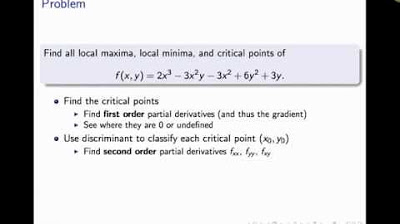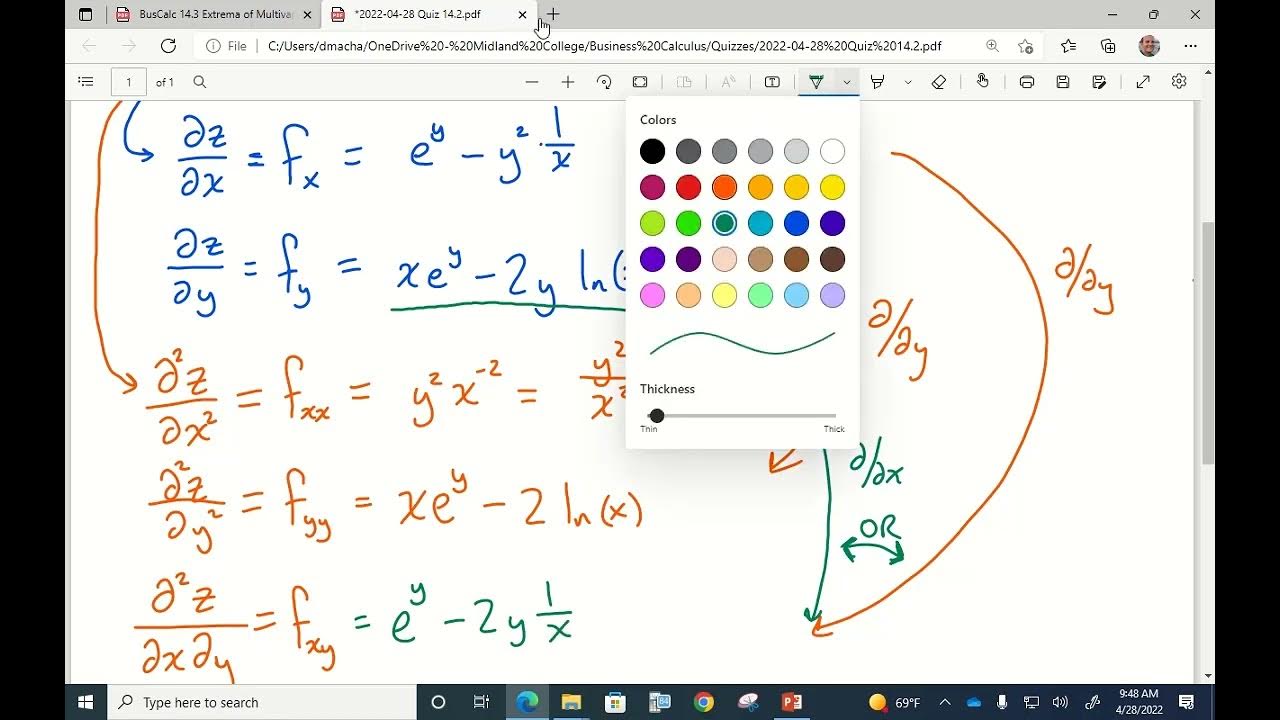Local extrema and saddle points of a multivariable function (KristaKingMath)
TLDRThis educational video script guides viewers through the process of finding local maxima and minima of a multivariable function, specifically f(x, y) = x^3 - 12xy + 8y^3. The presenter uses the second derivative test, beginning with calculating first and second order partial derivatives. After finding critical points by setting the first order derivatives to zero, the script simplifies the equations to solve for x and y, yielding two critical points: (0,0) and (2,1). The second derivative test is then applied, revealing that (0,0) is a saddle point and (2,1) is a local minimum. The script provides a clear, step-by-step explanation, making complex calculus concepts accessible.
Takeaways
- 📚 The topic discussed is finding local maxima and minima of a function using the second derivative test.
- 🔍 The function given is f(x, y) = x^3 - 12xy + 8y^3, and the first step is to find the first order partial derivatives.
- 📝 The first order partial derivatives are ∂f/∂x = 3x^2 - 12y and ∂f/∂y = -12x + 24y^2.
- 🔧 To proceed, the second order partial derivatives are calculated: ∂²f/∂x² = 6x, ∂²f/∂y² = 48y, and the mixed derivative ∂²f/∂x∂y = -12.
- 🔎 Critical points are found by setting the first order partial derivatives equal to zero, resulting in the equations x^2 - 4y = 0 and x + 2y^2 = 0.
- 🧩 Solving the system of equations yields two critical points: (0,0) and (2,1).
- 📉 The second derivative test is then used to determine the nature of these critical points by evaluating the discriminant D.
- 📌 At the critical point (0,0), D = -144, indicating a saddle point, which is neither a local maximum nor minimum.
- 📈 At the critical point (2,1), D = 432 and the second derivative with respect to x (∂²f/∂x²) is positive, indicating a local minimum.
- 📚 The second derivative test is a method to determine if a critical point is a local maximum, local minimum, or saddle point in multivariable calculus.
Q & A
What is the function given in the script for finding local extrema?
-The function given in the script is f(x, y) = x^3 - 12xy + 8y^3.
What method is used to find local maxima and minima in the script?
-The second derivative test is used to find local maxima and minima in the script.
What are the first order partial derivatives of the function f(x, y)?
-The first order partial derivatives are ∂f/∂x = 3x^2 - 12y and ∂f/∂y = -12x + 24y^2.
What are the second order partial derivatives needed for the second derivative test?
-The second order partial derivatives needed are ∂²f/∂x², ∂²f/∂y², and the mixed partial derivative ∂²f/∂x∂y.
How does the script simplify the first order partial derivatives to find critical points?
-The script simplifies the first order partial derivatives to x^2 - 4y = 0 and x + 2y^2 = 0 by dividing the equations by 3 and 12 respectively.
What are the steps taken to solve the system of equations for x and y?
-The script isolates x in terms of y from the second equation, then substitutes this expression for x into the first equation to solve for y.
What are the critical points found in the script?
-The critical points found are (0, 0) and (2, 1).
What is the formula used in the second derivative test to determine the nature of critical points?
-The formula used is D = (∂²f/∂x² * ∂²f/∂y²) - (∂²f/∂x∂y)^2.
How does the second derivative test conclude the nature of the critical point (0, 0)?
-The second derivative test concludes that the critical point (0, 0) is a saddle point because the value of D is less than zero.
How does the second derivative test conclude the nature of the critical point (2, 1)?
-The second derivative test concludes that the critical point (2, 1) is a local minimum because the value of D is greater than zero and the second order partial derivative with respect to x is also greater than zero.
What is the significance of the value of D in the second derivative test?
-The value of D helps determine if a critical point is a local maximum, local minimum, or a saddle point. A positive D indicates a local minimum, a negative D indicates a saddle point, and a zero D makes the test inconclusive.
Outlines
📚 Introduction to Finding Local Extrema
The script begins with an introduction to the process of finding local maxima and minima of a function, specifically for the function f(x, y) = x^3 - 12xy + 8y^3. The method to be used is the second derivative test, which requires calculating the first and second order partial derivatives of the function. The first order partial derivatives are found by differentiating with respect to x and y, resulting in ∂f/∂x = 3x^2 - 12y and ∂f/∂y = -12x + 24y^2. The next step is to find the second order partial derivatives, which are ∂²f/∂x² = 6x, ∂²f/∂y² = 48y, and the mixed derivative ∂²f/∂x∂y = -12. These derivatives are essential for identifying critical points and applying the second derivative test.
🔍 Identifying Critical Points and Applying the Second Derivative Test
The script continues with the process of identifying critical points by setting the first order partial derivatives equal to zero, leading to the equations x^2 - 4y = 0 and x + 2y^2 = 0. Solving these equations simultaneously yields two critical points: (0,0) and (2,1). To determine whether these points are local maxima, minima, or saddle points, the second derivative test is applied. This involves evaluating the second order partial derivatives at the critical points and using them in the second derivative test formula, D = (∂²f/∂x² * ∂²f/∂y² - (∂²f/∂x∂y)^2). For the point (0,0), D is calculated as -144, indicating a saddle point, while for (2,1), D equals 432, suggesting a local minimum. The second derivative test is used to conclude that (0,0) is a saddle point and (2,1) is a local minimum.
📉 Conclusion on Local Extrema of the Function
The final paragraph wraps up the process by summarizing the findings from the second derivative test. It explains that a negative value of D at the critical point (0,0) indicates that it is a saddle point, which is neither a local maximum nor a minimum. Conversely, a positive value of D at the point (2,1) confirms it as a local minimum. The script concludes by outlining the steps taken to reach these conclusions, emphasizing the utility of the second derivative test in analyzing the local extrema of multivariable functions.
Mindmap
Keywords
💡Local Maxima and Minima
💡Second Derivative Test
💡Partial Derivatives
💡Critical Points
💡Second Order Partial Derivatives
💡Saddle Point
💡Concavity
💡Discriminant (D)
💡Simultaneous Equations
💡Multivariable Function
Highlights
Introduction to finding local Maxima and Minima of a function using the second derivative test.
Function given is f(x, y) = x^3 - 12xy + 8y^3.
First step is to find first order partial derivatives.
Partial derivative with respect to x is 3x^2 - 12y.
Partial derivative with respect to y is -12x + 24y^2.
Second step is to find second order partial derivatives.
Second order partial derivative with respect to x is 6x.
Second order partial derivative with respect to y is 48y.
Mixed second order partial derivative is -12.
Finding critical points by setting first order partial derivatives to zero.
Solving the system of equations to find x and y values.
Critical points found are (0, 0) and (2, 1).
Using the second derivative test to evaluate critical points.
Second derivative test formula explained.
Critical point (0, 0) is a saddle point.
Critical point (2, 1) is a local minimum.
Conclusion on local Maxima and Minima using the second derivative test.
Transcripts
Browse More Related Video

Use the Second Derivative Test to Find Any Extrema and Saddle Points: f(x,y) = -4x^2 + 8y^2 - 3

Critical Points of Functions of Two Variables

Local Extrema, Critical Points, & Saddle Points of Multivariable Functions - Calculus 3

Second partial derivative test

BusCalc 14.3 Extrema of Multivariable Functions

Find and classify critical points
5.0 / 5 (0 votes)
Thanks for rating: